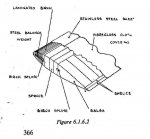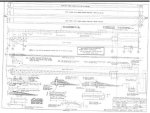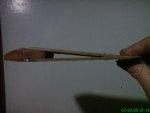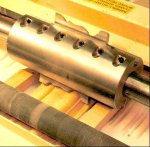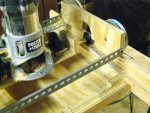You are using an out of date browser. It may not display this or other websites correctly.
You should upgrade or use an alternative browser.
You should upgrade or use an alternative browser.
Wood Rotors
- Thread starter Tex~N~Oz
- Start date
joe nelson
Senior Member
- Joined
- Jan 20, 2007
- Messages
- 1,297
- Location
- cincinnati,ohio
- Aircraft
- I have owned an AA-7B, Quad City Challenger, WAR P-47 and have flown several other type
- Total Flight Time
- 12000hrs approx
Bruce,
The Hoskin blades are the cheapest to manufacture being they are made of plywood. The other are made of spruce and birch with the rear section of balsa.
Construction was done by a router rail type jig set up for a 8H12 airfoil. This method takes a lot of labor out of the equation and makes accurate duplication easier. If I were to do it over, I would go for the CNC type machine so cord and length could be adjusted by computer.
Now I'm working on the next part in toward the hub. An elastomeric strap made of 304c stainless steel laminae, .009" thick. This eliminates the alpha and delta hinges leaving only the lead-lag hinge to design.
The Hoskin blades are the cheapest to manufacture being they are made of plywood. The other are made of spruce and birch with the rear section of balsa.
Construction was done by a router rail type jig set up for a 8H12 airfoil. This method takes a lot of labor out of the equation and makes accurate duplication easier. If I were to do it over, I would go for the CNC type machine so cord and length could be adjusted by computer.
Now I'm working on the next part in toward the hub. An elastomeric strap made of 304c stainless steel laminae, .009" thick. This eliminates the alpha and delta hinges leaving only the lead-lag hinge to design.
danmcgee
Member
- Joined
- Dec 1, 2008
- Messages
- 678
- Location
- Prince George VA.
- Aircraft
- Phantom, Zenair 701
- Total Flight Time
- 140
Ok guys here are the blades.
Dan
Dan
danmcgee
Member
- Joined
- Dec 1, 2008
- Messages
- 678
- Location
- Prince George VA.
- Aircraft
- Phantom, Zenair 701
- Total Flight Time
- 140
danmcgee
Member
- Joined
- Dec 1, 2008
- Messages
- 678
- Location
- Prince George VA.
- Aircraft
- Phantom, Zenair 701
- Total Flight Time
- 140
EI-GYRO yep I see it section CC is hollow in spots. Thanks should have looked at it closer.
dan
dan
EI-GYRO
21st Century Crankhandler
Innovator
Newbie
Bruce,
The Hoskin blades are the cheapest to manufacture being they are made of plywood. The other are made of spruce and birch with the rear section of balsa.
Construction was done by a router rail type jig set up for a 8H12 airfoil. This method takes a lot of labor out of the equation and makes accurate duplication easier. If I were to do it over, I would go for the CNC type machine so cord and length could be adjusted by computer.
Now I'm working on the next part in toward the hub. An elastomeric strap made of 304c stainless steel laminae, .009" thick. This eliminates the alpha and delta hinges leaving only the lead-lag hinge to design.
Joe,
Is this the type of Planer/Moulder you are referring to to produce the cut of the profile in wood?
http://www.woodmastertools.com/NS/accessdetail.cfm?PID=92
http://www.woodmastertools.com/s/planers.cfm
The blades for most Planer/Molders are under $100 from what I have seen. I would think there might be a lot of members interested if someone could make up some baldes for the NACA 0012 or NACA 8H12 profiles.
Does anyone own a Planer/Moulder?
Attachments
hello . may be this make it work http://www.wood-carver.com/gemini.html
joe nelson
Senior Member
- Joined
- Jan 20, 2007
- Messages
- 1,297
- Location
- cincinnati,ohio
- Aircraft
- I have owned an AA-7B, Quad City Challenger, WAR P-47 and have flown several other type
- Total Flight Time
- 12000hrs approx
Innovator,
My moulder is only 4.5" and would require three different cutters for the 8H12 airfoil. On the other hand, a router rail system that I built last year allows me to cut a couple of feet of blade at a time. The blade has to be turned over and the bottom has to be routed to finish it up.
The Wood Carver system would work ....it's just too expensive!!!!
I've been trying to post my pictures and since the forum upgrade I can't post anything but text.
My moulder is only 4.5" and would require three different cutters for the 8H12 airfoil. On the other hand, a router rail system that I built last year allows me to cut a couple of feet of blade at a time. The blade has to be turned over and the bottom has to be routed to finish it up.
The Wood Carver system would work ....it's just too expensive!!!!
I've been trying to post my pictures and since the forum upgrade I can't post anything but text.
joe nelson
Senior Member
- Joined
- Jan 20, 2007
- Messages
- 1,297
- Location
- cincinnati,ohio
- Aircraft
- I have owned an AA-7B, Quad City Challenger, WAR P-47 and have flown several other type
- Total Flight Time
- 12000hrs approx
Sorry, that's the type of moulder that I have. Mine is made by Jet and is relatively small compared to industrial ones. I have been told that some have up to a 9 inch cutting capacity. That would give you a good range of airfoil cords.
joe nelson
Senior Member
- Joined
- Jan 20, 2007
- Messages
- 1,297
- Location
- cincinnati,ohio
- Aircraft
- I have owned an AA-7B, Quad City Challenger, WAR P-47 and have flown several other type
- Total Flight Time
- 12000hrs approx
joe nelson
Senior Member
- Joined
- Jan 20, 2007
- Messages
- 1,297
- Location
- cincinnati,ohio
- Aircraft
- I have owned an AA-7B, Quad City Challenger, WAR P-47 and have flown several other type
- Total Flight Time
- 12000hrs approx
The small wheels, in the first picture, follows the airfoil template that guide the router along the rails. It will produce any airfoil by just changing the template. Assymmetrical blades are easy to make requiring only one pass of the router. Symmetric blades, however, take two passes due to their shape. The blades need to be turned over and leveled up before being fed into the jig.
Tex~N~Oz
Gold Supporter
Sorry, that's the type of moulder that I have. Mine is made by Jet and is relatively small compared to industrial ones. I have been told that some have up to a 9 inch cutting capacity. That would give you a good range of airfoil cords.
I have a huge 3-phase industrial shaper that could easily shape to 6" or maybe more.. I'd have to look.
I'm still at a stand-still over the types of wood. I don't have the traditional birch and spruce available to me here.. I have gums and oaks..
Edit..
I just looked and its will shape up to 12" but I don't think the feed rollers would be suited for that much pressure.. not sure.
The blades would have to be machined out of carbide for all the abuse they would take.
Last edited:
joe nelson
Senior Member
- Joined
- Jan 20, 2007
- Messages
- 1,297
- Location
- cincinnati,ohio
- Aircraft
- I have owned an AA-7B, Quad City Challenger, WAR P-47 and have flown several other type
- Total Flight Time
- 12000hrs approx
Bruce,
You could try marine or aviation grade plywood! I have several books from the EAA on building with wood. I'll look through them tonight to see alternatives for your problem.
You could try marine or aviation grade plywood! I have several books from the EAA on building with wood. I'll look through them tonight to see alternatives for your problem.
tyc
Newbie
Earthboundmisft
The 'FIXER'
- Joined
- Jun 1, 2006
- Messages
- 2,110
- Aircraft
- The 'MISSFIT' gyro, GRAND CHAMPION, Bensen Days 2010
- Total Flight Time
- 700 F/W, 227 Gyro
Hey, I just saw a 1932 Ford, all original, operational for $9500.00.
Then I saw a 2002 BMW for $9750.00.
Im just sayin....GET IT?
Then I saw a 2002 BMW for $9750.00.
Im just sayin....GET IT?
RotoPlane
Gold Supporter
Unless I am not following you guys, I see no need for more than a 4" shaper, if you make it similar to post #66. If you're talking of making a solid 8" airfoil shape….it would be one heavy blade and with a monster chordwise balance weight.
Hey, I just saw a 1932 Ford, all original, operational for $9500.00.
Then I saw a 2002 BMW for $9750.00.
Im just sayin....GET IT?
No...not really.
Some people like to build things, some people don't.
Some people like to experiment, some people don't.
Some people like old Fords, some people don't.
dloftus
Newbie
- Joined
- Jul 27, 2009
- Messages
- 62
- Location
- Gainesville, FL
- Aircraft
- None yet, looking at Ultrawhite
- Total Flight Time
- 10 hrs, 30 yrs ago, FW, most in a 1947 Aeronca Chief
I have a question regarding rotors. Has there ever been an inflight failure of a rotor blade? Especially the newer designs, like the Dragon Wings? Thanks.
Don Loftus
new member
Don Loftus
new member
Arnie Madsen
Member
- Joined
- Mar 14, 2007
- Messages
- 4,351
- Aircraft
- Bell 47 G2
Yes Don. There have been a few failures. Rare and sometimes hard to find the reason why.I have a question regarding rotors. Has there ever been an inflight failure of a rotor blade? Especially the newer designs, like the Dragon Wings? Thanks.
Don Loftus
new member
Wood blades do not fail because they are made of wood. They fail because they were exposed to the outdoor elements for 30 years , soaked up water and sometimes a bit of rot started at the root end or attachment braces. Wood blade that are failing give lots of warning , but if the helicopter has no life limit blades , and rely upon inspection, and the helicopter has been flying in tropical Guiana for 40 years ..... what is one more flight going to hurt with those fasteners all coming loose since last year..... that is when it can happen.
Modern metal bonded blades fail on occasion. Not because of the design , the design is usually good. Bonding adhesives used on rotor blades are proven and are an excellent way to fasten metal to metal. Problems with de-bonding are usually blamed on "quality control" which means the two part epoxy was not cured at the right temperature , material was not cleaned properly, or the assembler had a hangover that day.
Modern composite blades are becoming the industry standard. Composites are glorified high-end fiberglass construction using the best available materials. Blades can be shaped and formed in a "perfect mold" with a "perfect aerodynamic shape" and hundreds can be produced all exactly the same which is highly desirable in the industry. But they do fail as well. Quite rare , but it always comes down to cure times and temperatures and quality control. Failures are usually traced back to an inclusion or un-cured part of the laminated lay-up process that is hard to prove when the blade and aircraft is busted up on the ground.
Welcome to the forum Don , You have asked a good question. My response is mostly about helicopter rotors. It is rare to have an in flight failure but it can happen. Gyroplanes very seldom have in flight rotor blade failures. It is not an issue. As a matter of fact I do not know of one. For sure , never heard of a Dragon Wing rotor failing in flight. Somebody correct me if I am wrong.
Many thanks
Arnie.

